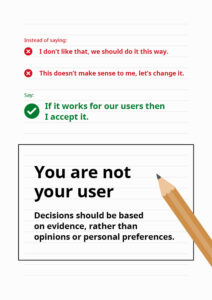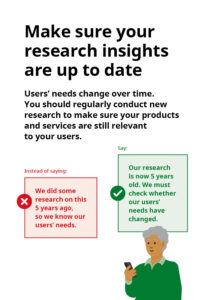Challenging assumption-based design: red and green flag statements
Policy details
| Metadata item | Details |
|---|---|
| Publication date: | 26 February 2024 |
| Owner: | Data Quality Hub |
| Who this is for: | Anyone involved in designing a product or service |
| Type: | Guidance |
| Contact: | DQHub@ons.gov.uk |
The GOV.UK Service Manual content helps teams to create and run great public services that meet the Service Standard. User research is an important part of the Service Manual as it helps teams to learn about users and create services that meet their needs. Without carrying out research with your users, you will not know:
- what problems you’re trying to solve
- what to build
- if the service you create will work well for them
It can be easy to refer to opinions or make assumptions about how we should design our products and services. This is particularly easy to do when we are under increasing pressure to complete work quickly, or with limited resources. However, designing based on opinions and assumptions can risk us:
- designing the wrong thing
- creating products or services that are not well understood by users
- creating products or services that are not used by those they were designed for
- collecting data, which are inaccurate, unreliable, or poor quality
- increasing burden
It is important that our design choices are user-led and based on evidence. This helps us ensure the product or service we are designing meets the needs of its users. There are some phrases that you can listen out for when designing services and products that show that evidence is not being used to inform the design decisions. We have called these ‘red flag statements’ and have created a series of posters to help you to identify them in your work. The posters will also support you when challenging these statements when they are spoken by others, where necessary.
How to use the posters
Each poster gives an example of common red flag statements which are sometimes heard when designing new products and services. A product or service might include a government service (for example, the application process for a driving license), a survey or questionnaire (including question design and respondent materials), or a website. These posters can be used to:
- help you to identify common red flag statements, and acknowledge the effects that these could have on quality
- help you to challenge these red flag statements and provide you with alternative ‘green flag statements’
- promote evidence-based decision-making, to ensure that our products and services meet user needs and are good quality
The red flag statements are informed by opinions and assumptions, which means they should be challenged. Next to these red flag statements are examples of green flag statements. These statements give examples of what you should expect to hear when decisions are being made on evidence rather than opinion.
This guidance is designed to accompany the posters. It gives further information about the statements used in the posters and explains why it is important to use evidence-based decision making. If you are working on surveys, you can substitute the word ‘user’ in the statement for ‘respondent’.
What the posters say
Poster 1
Make decisions based on user research.
Instead of saying “I think a user needs this”, say “The research shows that users need this”.
What you should do
It is important to make decisions based upon user needs. Research can help us to truly understand what these are.
Our decisions should be based upon evidence, rather than opinions or assumptions.
User needs should be clearly defined in the planning stage of your project and can be iteratively updated throughout the research process as the product or service is developed.
What you should not do
We should not make decisions based upon assumptions. This may lead to a service or product that is not fit for purpose.
Do not wait to define your users’ needs until you have developed your product or service. It is important to test your product during the later stages of development to determine whether it works for your users, but you can avoid the need to make big changes at a late stage by clearly defining your user needs before you develop your product .
Poster 2
Instead of saying “I don’t like that, we should do it this way”, or “this doesn’t make sense to me, let’s change it”, say “if there is evidence to support this approach, I accept it”.
You are not your user. Decisions should be based on evidence, rather than opinions or personal preferences.
What you should do
Your product or service should be reviewed and tested by users to ensure that it meets their needs. Changes should be made based upon these findings.
It is important to consider the needs of different types of users. For example, if you are creating a survey, you will need to consider the respondents’ needs, as well as the data users’ needs to ensure:
- the respondent can complete the survey
- the data user can use the data as intended
What you should not do
Do not skip user testing!
Do not prioritise the needs of one user group over another. Ensure you consider the needs of all your users. If advice seems contradictory, you should make compromises based upon evidence of which elements best suit user needs.
Poster 3
Instead of saying “I think that will confuse users” say “we must test this to see if users understand it”.
Avoid making assumptions about your users. Test your products and services to ensure users are able to understand, use and interpret them as intended.
What you should do
Products and services should be tested to ensure users understand, use and interpret them as intended.
You should consider the accessibility of your product or service and design it with this in mind. Products and services should be designed so that they are simple and easy to understand without the need for guidance or additional instruction, unless necessary.
Remember to consider groups who may have additional accessibility needs, such as:
- users with low vision
- people who use screen readers
- users with dyslexia
What you should not do
You should not make assumptions about the level of understanding that users may have.
Do not design products or services in a way that makes them complicated or difficult for users to understand or use.
Poster 4
Make sure your research insights are up to date. Users’ needs change over time. You should regularly conduct new research to make sure your products and services are still relevant to your users.
Instead of saying “we did some research on this 5 years ago, so we know our users’ needs”, say “our research is now 5 years old. We must check whether our users’ needs have changed”.
What you should do
You should ensure the research you are using is up to date and relevant to the world as it is today.
The different needs of your users may change over time. Whilst your product may have been originally created to meet these needs, it should be revisited to ensure the product or service is still useful and meets the needs of users, should they have changed.
What you should not do
You should not assume that research conducted in the past, or for previous projects is relevant and applicable to your own product or service.
Poster 5
Instead of saying “we have really tight deadlines for this project, we don’t have time to test with users”, say “user testing is important, let’s see what changes we can make to fit it in”.
Make time for user testing. When creating your project timeline, plan in time to test and iterate your product or service. This will ensure that it meets all your users’ needs.
What you should do
It is important that you leave enough time in your research plan to review and test your product or service to ensure that it meets all your users’ needs.
You should assess the best type of research depending on:
- the available time
- and the available resources
- what the research question is
Of course, sometimes even the most carefully planned timeline will need to be adapted. You may find yourself with less time than you need to conduct comprehensive research. If this is the case, you should evaluate the risks and caveat the research findings.
Remember that testing and review is an iterative process. It should be repeated where possible throughout the design process.
What you should not do
Do not rush your testing and review processes. These are an important part of the design process. If you fail to put aside enough time to for testing and review, you may create a product that does not meet your users’ needs.
Downloadable versions of the posters
You can download PDF versions of the posters from the Data Quality Hub GitHub page.





